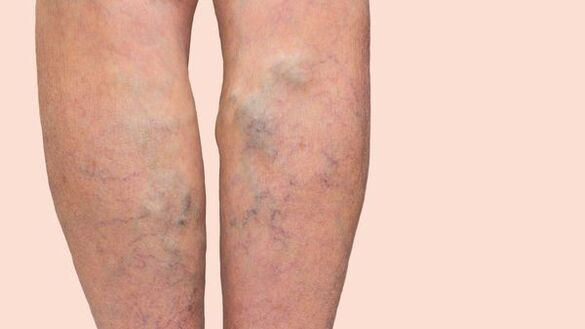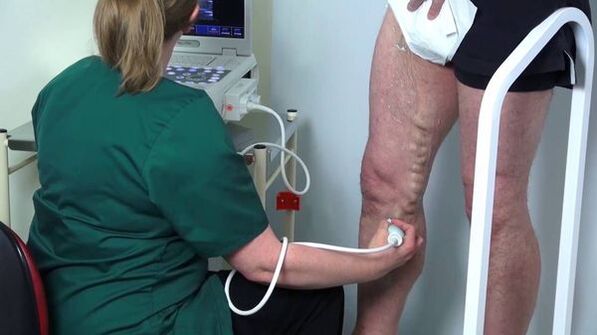Varicose veins are a disease in which the veins in the legs are very sore in the first place. What to do when symptoms appear, how to treat varicose veins and what factors are the basis for the development of the disease? Knowledge of these problems will help to avoid the negative consequences of the disease.
General information about varicose veins
The carrier of varicose veins is almost one in five people of the total percentage of the world population. The main threat of the disease is that its symptoms cannot be noticed immediately, so timely treatment is delayed, and the disease leads to complications.
The full medical name for such a disease is varicose veins. By the name it can be understood that in the presence of a disease, the peripheral veins located in the extremities of the human body increase in size, thus acquiring a swollen and unhealthy appearance.

With varicose veins, knots, cobwebs, clusters, and other non-standard vein entanglements can appear on the skin. Its color deepens, edema and pain appear. Due to the appearance of nodes, the blood cannot flow stably through the veins, blood clots form, which causes the veins to be exposed to high pressure.
Reaching a certain pressure indicator leads to the fact that during thrombosis, the blood in the veins is pushed out, stretching the walls of the vessels. The first characteristic symptoms of varicose veins appear, such as a noticeable intertwining of the veins, an expansion of their volume and a deep blue tint.
Very often, varicose veins cover the surface of the legs, which is why people suffering from such an ailment complain of pain in the veins of the legs. Treatment of varicose veins should be immediate and carried out under the supervision of an experienced doctor. When the first symptoms appear, contact a therapist.
Causes
The main cause of varicose veins is the interruption of stable blood flow. It is the stagnation of blood in the veins that leads to pressure being exerted on them. Therefore, the main factors that affect the development of varicose veins include:
- Genetic predisposition. If both parents suffered from varicose veins, then the probability of developing the disease in their child can reach 70%. The first symptoms of the disease appear at an early age, and the development of the disease can be prevented with medical care.
- Increased physical activity. Regular and prolonged standing can strain your blood vessels. Therefore, varicose veins are often found in professional athletes and in people who are subjected to hard work of physical production.
- Lack of physical activity. With the complete absence of movement in the blood vessels, stagnation of blood occurs. Older people, as well as office workers who lead a sedentary or sedentary lifestyle, can suffer from varicose veins.
- Hormonal imbalanceFunctional disorders of the hormonal or endocrine system of the human body can have various consequences. For example, female representatives are faced with stagnation of blood in the vessels. Hormonal disturbances can occur during puberty, pregnancy, lactation, menopause, as well as due to stressful private situations and nervous disorders. During such periods, estrogen does not prevail in the woman's body, but the hormone of the corpus luteum, which acts on the muscles in a relaxing way.
- Mechanical effect on the veins. Contraction of the peripheral veins located on the surface of the extremities can also affect the appearance of blood congestion. For example, tight clothing has that effect.
- Alcohol abuse. Alcohol contains substances that are toxic and poisonous to the body, and it also increases blood pressure. Toxins and pressure cause blood vessel walls to lose firmness and tone.
- Obesity. Excess food intake leads to rapid weight gain, as a result of which the extremities of the body may not tolerate the load placed on them.
When the veins hurt exactly on the legs, then the cause of the painful sensations, as a rule, is varicose veins. You should pay attention to the factors that could affect the development of the disease and review the lifestyle.
Symptoms
Before starting the treatment for varicose veins, you need to make sure that the veins are very sore precisely due to the appearance of such ailment. The disease is not asymptomatic, the main thing is to pay attention to any deviations from the norm in the work of the body. The following manifestations speak of varicose veins:
- Pain in the legsThe pressure exerted by the blood on the vessel walls causes painful and uncomfortable sensations in the lower extremities. So the vein hurts, you may face an unpleasant burning sensation and heaviness in the legs.
- Swelling. Swelling on the surface of the legs may appear towards the end of the day, when the extremities are experiencing peak stress. The swelling affects not only the main part of the legs, but also the feet, ankles and the flexion area of the knees.
- Seizures: Convulsive muscle contractions with varicose veins, as a rule, occur at night. They can be accompanied by a nervous tic and convulsive spasms.
- Expansion of the veins. As noted above, varicose veins take on a completely different look. They are swollen, sinuous, and deep blue. Large saphenous veins indicate the presence of thrombosis.
- Discoloration of the skin. Due to the fact that during the disease a stagnation of blood appears in the vessels, the skin under the peripheral veins can change its tone to a darker and dull one.
- Trophic ulcers. Due to a violation of the blood supply to the skin, defects appear that do not heal for a long time.
The most primary symptoms of varicose veins are fever and general weakness of the body.
If you start treatment of the disease, it can turn into the next stage. With the rapid development of varicose veins of the lower extremities, you may encounter the following symptoms:
- hardening of the skin;
- dark spots;
- loss of moisture on the skin, violation of its nutrition;
- bleeding caused by ruptured nodes.
If one of these symptoms occurs, you should visit a doctor and start treatment immediately.

Treatment methods
If the veins of the legs hurt precisely because of varicose veins, the specialist will prescribe a wide range of measures to eliminate the disease. The most common treatments for varicose veins include:
- medical preparations;
- home remedies;
- gymnastics;
- massage;
- bandaged compresses and affected areas;
- special diet.
Treatment will be more effective if the patient accepts a holistic rather than selective approach.
Medicines
Medications for the treatment of varicose veins can be divided into 4 groups:
- External use;
- for oral administration;
- to eliminate symptoms;
- to treat the underlying causes;
- operating methods.
In the fight against the disease, doctors prescribe drugs that thin the blood, painkillers and anti-inflammatory drugs, a complex of vitamins, etc. Oral medications can be administered orally or by injection.
Any drug should be used only under the supervision of the attending physician, observing the instructions for use and the duration of treatment.
Home remedies
Home remedies for the treatment of varicose veins should complement a set of measures to eliminate the disease. You can use them at home.
Common folk methods include:
- medicinal baths;
- compresses
- decoctions of herbs.
Baths are recommended for the effective treatment of varicose veins 3-4 times a week. The water should be diluted with special sea salt for baths or special herbs prepared in advance. For example, you can use the following recipe:
- Fill the bathtub with lukewarm water.
- Dissolve the dried leaves of medicinal herbs in water.
- Take a bath for 20-25 minutes.
Chamomile, St. John's wort, oak bark and banana leaves, which can be bought at any pharmacy in the city for a small fee, are suitable as raw materials for baths. It is possible to take such baths for prophylactic purposes, because they help to cleanse the vessels of toxic substances, and also to stabilize blood flow.
Compresses and lotions can be made with pharmacy essential and vegetable oils, aloe juice, or honey. To do this, you need to apply one of the listed components to the areas affected by varicose veins, and then wrap the application area with an elastic bandage. You should change such compresses twice a day every 2-3 hours.
You can prevent the development of the disease in a popular way by consuming decoctions of medicinal herbs inside. For the preparation of broths, the raw materials of the following herbs are suitable:
- Espino;
- chamomile;
- hop cones;
- plantain;
- Grass of San Juan;
- licorice root;
- Angelica root.
You should consult your doctor in advance about alternative methods. Some components may not be usable due to allergic reactions.
Gymnastics
One of the reasons for the development of varicose veins is inactivity, which causes stagnation of blood in the vessels. Therefore, people who are forced to lead a computer lifestyle should regularly perform gymnastic exercises at home. For instance:
20-25 times:
- Sit in a chair
- Bring your legs together
- Tighten your muscles
- Lower your feet down to your toes and then down to your heels.
20-25 times:
- Lean against the wall with both hands.
- Climb on tiptoe
- Step on your heels
15-20 times:
- Sit down
- Stand on your toes while sitting
- Step on your heels
15 times on each leg:
- Sit down
- Raise your right leg parallel to the ground for 7 seconds.
- Lower
- Do the same with the left leg.
Massage
Massage for varicose veins can be performed independently at home. You will need a special nourishing cream or oil. Sea buckthorn is perfect. It should be rubbed on the problem areas of the legs in a circular motion for five minutes a day. This procedure will also increase the elasticity of the skin and nourish it with moisture.
Diet
The diet for varicose veins implies a restriction in the consumption or a total rejection of the following foods:
- broths
- marinades;
- salty, smoked, sweet, oil-fried foods;
- coffee and derived beverages;
- alcoholic and tobacco products.
It is worth diversifying the diet with foods that have a positive effect on strengthening the walls of blood vessels:
- fresh fruits and vegetables;
- walnuts;
- fish products, seafood;
- vegetables;
- fermented dairy products.
Operational methods
There is a treatment for varicose veins and through surgical intervention. However, it is used in extremely advanced cases. The operations consist of ligating the veins of the esophagus and stomach with the imposition of an anastomosis or in the placement of a stent in the conduit between the portal and hepatic veins.
To avoid varicose veins, it is advisable to rest your legs and perform preventive procedures at home. The effective treatment of already arisen varicose veins consists of a timely and complex treatment under the guidance of a specialist.
Which doctor to contact
Treatment is carried out by a phlebologist, a vascular surgeon.























